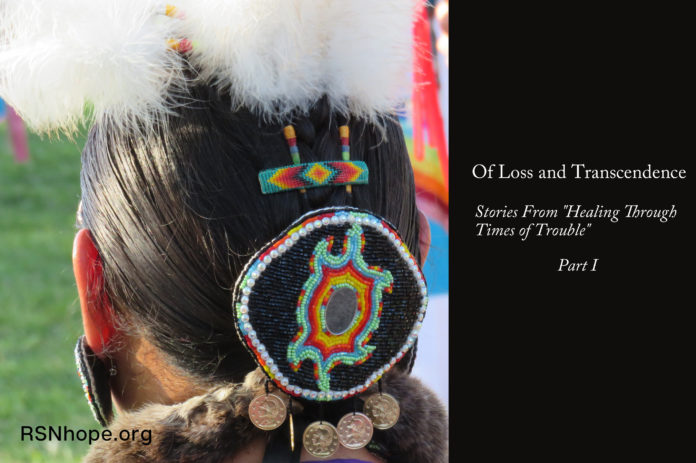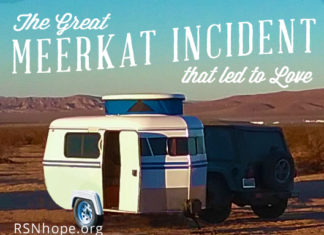In Part One of this special article, the author describes his personal experiences with some extraordinary chronically ill patients who found a spiritual, even transcendent, meaning to their lives while ultimately facing that final journey we must all take. These include Denise Eilers, who describes what she learned as caregiver for her beloved husband who was on home hemodialysis for a quarter of a century in two perceptive and heartfelt articles published on the KidneyTimes website (see EasyLink Access numbers 108 and 200); Ron, who first refused dialysis, then relented and had a great time as his unit’s court jester; Florence Nightchase, a Lakota Sioux who danced her way to the Light in an hours-long Pow-wow after being told she would have to stay off her feet 24/7; and Christina, who bravely fought the “cavity” in her soul.
Introduction by Denise Eilers
Denise Eilers dialyzed her husband, Jerry, at home for nearly 25 years1,2. In a wonderful series of e-mails, she described years rich with love, commitment, and a fiery determination to cherish every hard-fought-for joy of life. In my naiveté, I commented how awed I was at their ability to “soldier on” through all the struggles faced by a dialysis patient and family. She stopped me cold:
While on the machine, Jerry had supper, visited with non-squeamish friends, and played games with our son. He maintained his positive attitude and a wicked sense of humor, going so far as to tell some people he slept with his dialysis nurse. (Now, that got us some strange looks)… The period from 1980-2000 was unbelievably normal. He did have bypass surgery in 1998, but recovered quickly and well. In 2000, after a “freak” fall and hip fracture, he developed a perforated colon resulting in an ileostomy and failure of his original fistula. Again, despite a long hospitalization and several stays in ICU, he recovered well. But, by 2004, abdominal pain, neuropathy, congestive heart failure, and a foot wound started slowing him down. We never felt we were “soldiering on.” Jerry just felt dialysis was part of life, like driving to work or changing the oil in the car.
Mechanically, dialysis is an elaborate washing machine designed to normalize body chemistries and fluid volume. While those of us who work in dialysis struggle mightily to run the machine well, we find ourselves witnesses and students of a drama much larger than the few hours we attend our patients. It’s a peculiar commerce: we’ll give them our best efforts, our hearts and careers, and harass them about their Kt/V, their phosphorus, and their unacceptable fluid gains. In return, they’ll teach us how to survive, how to forgive, and how to rise above the countless challenges they face every day.
Over the last three years, I’ve had the pleasure of working with Joni Walton, a nurse educator in Montana, to honor some of our patients’ experiences in a book we’ve called Healing Through Times of Trouble3. Following are a few of those stories.
Ron: When Everything Changes
Ron’s room was dark, no air movement, not a sound. I thought he’d died in the night. When I checked his pulse, his eyes snapped open–now, that was weird! I asked him what was up.
“‘Doc, I’m not starting dialysis. There’s no point. Nobody cares if I live or die.”
Because I was working on a chapter in Medical Care of the Soul4 about the purpose that justifies what we go through, I said: “Okay. Is there anything you need to finish before you die?”
He looked at me like I was crazy, then grumbled that he would tell me the next morning. Next day, the drapes were open, and there was Ron with a list four pages long: he had to get his dog placed, maybe talk with his son after 20 years out of contact, not to mention that he had a huge room stacked to the ceiling with newspapers he’d like to read. How long would that take? He studied his list.
“Oh, probably four months.”
There was no way he would make it without dialysis.
“Well, then, of course, Doc, put me on dialysis,” he relented.
Five years later, he’d never done one thing on his list, but he’d had a great run as our dialysis unit’s court jester.
“A Bargain With God”
Viktor Frankl survived the Nazi death camps to build a psychology around finding the point that justifies life’s inevitable suffering5. One fellow inmate told Dr. Frankl he’d made a bargain with God: as long as his suffering eased that of his wife in another camp, or gave her a better chance of living, he could handle the worse his captors could do to him.
Life in general, and dialysis in particular, involves a pot load of hardships. The “palliative” aspects of our care aim to minimize the inconvenience and pain. But what really may matter most, what gives us the strength to keep going, is finding the purpose for these days and years we go through (there is so much to attain).6 What is it you want to experience or complete in the time you have left? What regrets will you have that you can turn into wondrous satisfactions?
Denise and Jerry Eilers lived what Rachel Ramen says so well: “The goal of healthcare is not health. It is to achieve what we need to in the time we have left.” For Denise and Jerry, that was loving their family and friends, relishing life’s pleasures, and finding humor in the moment.”
Florence: Dancing to the Light
One of my career’s greatest pseudo-successes was my patient, Florence Nightchase. Florence was the senior women’s dancer for the Lakota Sioux in the San Francisco Bay area. Her diabetes had led to ray amputation of two toes, which left her foot looking like a gull’s wing. The rest of her leg could be saved only with precise wound care and staying off the foot 24 hours a day.
As summer came, she pleaded to go to the Dakotas for a Sundance. Two of her sons were to dance, be pierced, and have their vision quests. Having seen Florence at local Pow-wows, I knew she’d be right in the thick of it.
We struck this deal: I’d arrange dialysis there, but only on the condition that she’d stay off her foot entirely. She gave me her absolute promise.
“Honest Injun,” she joked, indicating that it would be so.
A Shaman Healing?
Two weeks later, she returned energized, hungry as a wolf and with her foot completely healed! She assured me she’d been a model patient.
As I was walking away, congratulating myself on my skills at manipulating this wily old matriarch, I overheard Florence crowing to the patient in the next chair: “Oh, it was wonderful! My sons did the rituals for 36 hours! I met with the Shaman, and he and I danced for most of a day and a night. He drew the evil out of my foot down into the earth, and it has not hurt one minute since then.”
We hope for a cure. We dream of power, and control, and peace. To this day, it hurts my ego that when someone gets better, it’s chalked up to Jesus or the patient’s “always having been a fighter.” But if they get worse, everybody figures I must have screwed up. Oh, well…
Perhaps we should be hoping for something much more. How about wonder? And joy? And lightness? Does it matter whether God or betadine, T-lymphocytes, or a nurse’s profound touch beat the infection? Maybe we come into this crazy business just to stand in the radiant presence of healing energy, whatever its source.
Battle: the Ethics Consultation
Illness awakens an army of ancient thugs: family troubles, old hurts, guilt, fear, resentment of those in power, and our own powerlessness. When everything else has failed, decisions are sometimes delegated to an Ethics Consultation. The goal is to have those who consider themselves expert–nurses, doctors, therapists, social workers, chaplain, lawyers even and those facing the decision, [including] family, friends, and the patient–figure out what’s “best.”
We were entering the second hour of a particularly anguished “consultation” when Christina shifted in her seat and drew back a lock of weathered hair.
“Maybe you people can fill the cavity this is leaving in my Soul.”
The conference room went silent. Christina had made it clear she was going to keep us from giving up on her fourth “husband,” the one who, since her daughter’s 10th year, had been “Dad.” It had taken us an hour to battle our way down into the depths where these things are really fought out.
“He always recovered before,” she insisted.
Well, not this time…
The Tough Questions
“Why did his kidneys fail?” Because they’ve been failing for five years. Forty years of hepatitis virus have ravaged his kidneys as voraciously as they have everything else in his body.
“Won’t dialysis wake him up?” Yes, but only so he can be aware of his dying.
“Are you just tired of keeping him alive?” You bet. Because all we’re doing is prolonging a life so miserable we feel like his torturers.
“Why can’t you just dialyze him?” Because it’s unethical: I’m increasing his suffering without any belief I can give him an outcome he’d appreciate.
The Wedding Dance
Often, just over my left shoulder during ethics consultations, plays a lovely wedding scene from the movie Gandhi. The betrothed link hands and together take a series of steps, each a quarter turn to the right. With each step, they speak the next promise as they move to a deeper layer of understanding. Slowly, the words and the wisdom begin weaving two strangers mystically, gently, into one.
Each time we come together to consider the last of a life, we begin a Ghandian wedding dance. Each dance, in time, will cast its unique illumination on the wonder and tragedies of human experience.
We went around the table, each specialty saying why we shouldn’t drag out Igor’s suffering, the family struggling, one son summarizing: “Well, this just sucks.” Right on. We link hands and step a quarter turn, deeper to the right.
I try to impress on the family that this is not about “giving up.” All of us–Igor, his family, the healthcare providers–need to be protected from pointless wounding. Igor is staying alive for two reasons only: because he thinks he has to do it for his family, and his family thinks they must insist on it for him. It’s time to offer everyone permission to lay down this battle.
We take hands, make another quarter turn to the right.
Christina says: “I’ve laid three husbands in the grave. This will be the fourth. Nothing will ever fill this horrible emptiness inside me. Igor’s and my 12 years together have been a holy hell, his sons can tell you. But I can’t stand it ending like this.”
A Shoulder “Cavity”
And another quarter turn.
“We’re living on his IHSS [in-home support services income],” Christina continued. “I’m taking a course in medical billing, but I have six months to go. My daughter will lose her ‘Dad,’ and we’ll lose our home at the same time.”
This ferocious warrior woman had demanded we keep Igor alive months longer than we thought appropriate. Now, for the first time, when it gets down to dollars, she collapses into tears. She is clutching the spot near her left shoulder, the one where the “cavity” will live forever.
We have opposing goals: I that my patient have a peaceful death and we stop wasting precious resources and people; she for absolution and a few more months of government largesse. Two recent books touch on the tremendous financial costs and failures of our healthcare system: Better: A Surgeon’s Notes on Performance, by Atul Gawande, and How Doctors Think, by Jerome Groopman, who also authored the superb The Measure of Our Days7-9. I believe the best we can hope for at such anguished points of decision is that we be aware–aware that we’re all trying to do the best, yet aware of the monsters in the room–habit, longing, fantasy, dollars, struggles over who’ll “win,” the knowledge that we’ll carry for the rest of our lives the burden of the story we’re writing today.
Samuel Johnson said: “There is no point… in hopeless sorrow.” We hope for a cure, for wholeness, for joy. But, when these are not available, we too often break ourselves on the hard rack of the impossible. Instead, we should put our energy and spirit into finding better, more realistic hopes. We may think we’re discussing whether or not to do the next procedure. But a much deeper part of us is scrambling to fill unfillable holes, while, at a deeper level, we’re hoping to experience ourselves and one another as the finest a human can be.
The Way of the Heart: the Piercing Ceremony Joni Walton recounts:
I’m in the dialysis unit when a pretty young Native American woman agrees to talk to me about her spirituality while she’s being dialyzed. Her long, dark hair reaches to the colorful blanket that covers her legs. I pull up a chair, and she asks me to move so close to her, I’m right in her face. The energy of her excitement heats me as she shares her stories and her plans.
“I didn’t know how to handle dialysis,” she explained. “I’d skip treatments. I kept getting sicker. My Uncle told me to get my things together. He said he was going to have a ‘piercing ceremony’ to help me accept dialysis. We were going into the hills for a sacred journey. I gathered up my moccasins, a leather dress, blankets, food, tobacco, and a buffalo robe. I also found a lady who ‘paints’ a spiritual type of body painting done with fasting and prayer.
“My family, including Uncle, his wife, and the painting lady traveled up to the hills. We set up the camp where we’d prepare for the ceremony. The painter lady covered my body with various colors. I stayed awake all that night. I was kind of afraid, but my uncle said that he was going to be with me. He prepared a circle around a tree. The circle was to protect us. We were fasting and praying.
“Uncle pierced himself to the tree. He had a rope that went through the skin on his chest, and he was tied to the tree. It bonded us. It rained, thundered and [there was a lot of lightning] throughout the night, but, within the circle, we never got wet. For all the pain Uncle was in, he never showed it. Animals such as coyotes would come up close to us, but wouldn’t enter the circle. I felt protected. I was so thirsty, but could not drink any water.
“I heard the wind blow loudly and Uncle cried, ‘He is coming!'”
“Who?” I said.
“The Wind,” said Uncle.
“I looked at the sky. The trees were swaying. I could hear the wind, but I did not feel the wind. I could feel only stillness. I felt protected. Still pierced and roped in the wind, Uncle was praying with his pipe. I felt that everything was alive–the wind, the animals that came up to us and surrounded us, but would not enter the sacred circle. In the morning, my family came after us and… washed the paint off. Then we went through a ‘sweat’ to pray for acceptance.
“Now, when I come to dialysis treatments, I don’t like it, but I come. Sometimes, I come late. Those things such as the piercing ceremony get me through dialysis. We pray to the same God. The One who created everything.”
References
1. Eilers, D. “Hope. Sprinkled With a Generous Dose of Humor, is How My Husband Dealt With Kidney Failure.” KidneyTimes, Web ID #108. April 2007.
2. Eilers, D. “If You Could Read My Mind, Love.” KidneyTimes, EasyLink Access #200. May 2007.
3. Bartlow, B. Medical Care of the Soul. Johnson Books, Boulder, CO, 2001.
4. Walton, J, and Bartlow, B. Healing Through Times of Trouble. PublishAmerica, Frederick, MD, 2007 (in press).
5. Frankl, V. Man’s Search for Meaning. Washington Square Press, New York, NY, 1984.
6. Warren, R. “The Purpose Driven Life: What on Earth am I Here for?” Inspirio, Grand Rapids, MI, 2003.
7. Gawande, A. Better: A Surgeon’s Notes on Performance. Metropolitan Books, New York, NY 2007.
8. Groopman, J. How Doctors Think. Houghton Mifflin Co., Boston, MA, 2007.
9. Groopman, J. The Measure of Our Days: New Beginnings at Life’s End. Viking Press, New York, NY 2007.
 About the Author
About the Author
Bruce Bartlow, MD, is a nephrologist and intensivist practicing in Redding, CA. His books, Medical Care of the Soul, and the soon-to-be released Healing Through Times of Trouble bring together 35 years of medical practice with the input from dozens of workshops he’s given around the country. He believes that all of us– healthcare providers, patients and families–bring our own wounds to an illness, hoping to learn, to teach, and to heal one another. Excerpts from Healing Through Times of Trouble are being published with the kind permission of PublishAmerica. For more information, log onto: www.publishamerica.com. If readers have any questions or comments or wish to share their own stories with the author, he may be contacted at: [email protected].
07/01/2007
Web ID 374







